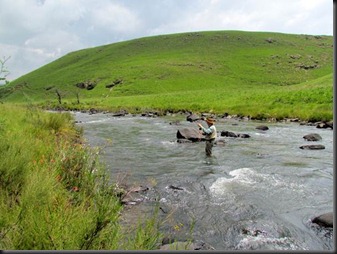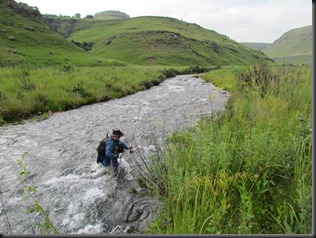In KZN we generally don’t do our fly-fishing for Trout in big strong rivers. As a result there is not a lot written about wading and wading safety or difficulty in these parts. But of course at this time of the year, it is not impossible to find yourself on a fast piece of water, that is still clean enough for you to want to fish it.
Generally the Umgeni is unfishable from a water colour perspective, if it is too fast to wade. The Mooi, and the Bushmans on the other hand, can run a pale slate grey colour, with lots of white water, and be fishable. Fishable that is, with a fair amount of lead on the business end, if you are working a nymph.

And as I have written elsewhere, our KZN rivers are not as easy to wade as those of the North Eastern Cape, where one has the luxury of long gravel beaches and spurs to wade along. The Mooi has many stretches of nasty angled rock, tossed into runs like those “dolosse” on a breakwater. Sharp angled pieces, that scatter the river bed, with deep crevices and holes between them. Then on the upper Bushmans there are stretches where the water’s edge signals a vertical drop into the river channel, and in high water to step off there would see you in 4 ft of fast flowing water.
So on these hot summer days, with big storms on the calendar, one needs to be mindful that you might find some strong water. Shaun Futter tells me he uses one of those expanding hiking staffs to good effect. He attaches it to his belt with a magnetic net attachment , and a plastic curly cord. This allows him to have it at his side all day, but if he does drop it, it floats off a short way and just dangles from the cord to be retrieved when he is ready. He tells me it is a handy tool for prodding the path ahead for snakes too. A smart idea! I tried it when he and I fished yesterday, and to tell you the truth, I think without it, I would have taken a good dunking along with my camera. I felt decidedly shaky during at least two of our river crossings, and I leant heavily on the staff to good effect.

It was also lighter and easier to carry than my old staff. That one is a lovely stick, which my father cut from a pear tree in our orchard when I was 12 years old. I have treasured it ever since, and still have it, but perhaps it will be retired to dog walking duty now.
Apart from a wading staff, a good pair of boots with ankle support is essential for when your foot lodges between two rocks at an awkward angle (and believe me, if you wade as often as I do, that happens all the time).
And then there is technique. My advice is that you should shuffle forward with your leading foot while your body weight is still on the back foot, and find a good foothold, BEFORE your weight passes onto the leading foot. Kind of like you would do if you were making your way through a dark and unfamiliar room at midnight. Left toe out in front, and right leg bent to keep your centre of gravity down. And by a good foothold, I mean one that is on a bed of the smallest stones you can see. In other words rather have your grip relying on several small stones, or a patch of gravel, than on a single rock that you might suddenly find is loose, or slippery. And to do this, might mean choosing to wade a deeper route in order to be safer. The staff is most effective if pointed into a secure hole downstream and ahead of you, and if you have put your rod away in the rod holder of your vest, all the better, because then you can clasp the handle with both hands for extra strength.
Rock hopping is fine when the river is showing its bones, and every leap has multiple subsequent options by way of various suitably exposed rocks less than two steps away. But in heavy water, when few rocks are showing, I would recommend that you rather plod between the higher rocks, and avoid leaping about. Leaping about means slipping and doing an ankle and a good fly-rod at the same time. Rather wade around a higher rock, and hold onto it for support, than balance atop the thing.
One Response